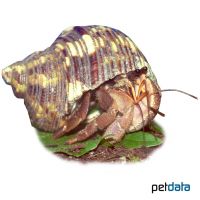Indonesian Crab (Coenobita brevimanus)
| Indonesian Crab Coenobita brevimanus | |
|---|---|
| Name | Indonesian Crab |
| Name Lat. | Coenobita brevimanus |
| Family | Terrestrial Hermit Crabs |
| Family lat. | Coenobitidae |
| Order | Decapods |
| Order lat. | Decapoda |
| Origin | Indo-West Pacific coastline |
| Habitat | Seashores |
| Diet | Omnivore |
| Humidity | 70-90 % |
| Behavior | Nocturnal, peaceful |
| Keeping | Group |
| Care Level | Moderate |
| Housing | Humid terrarium |
| Breeding | None reported |
| Life Span | 5-10 years |
| Protection | No |
| Metric Units | |
| Size | 10-15 cm |
| Temperature Day | 22-28 °C |
| Temperature Night | 20-22 °C |
| Housing Size | 80 x 40 x 40 cm |
| US Units | |
| Size | 4"-6" |
| Temperature Day | 72-82 °F |
| Temperature Night | 68-72 °F |
| Housing Size | 30" x 15" x 15" |
Distribution and habitat
The crepuscular to nocturnal short-scissor land hermit crabs are widely distributed along the coasts of the tropical Indo-Pacific from Zanzibar to Tahiti and Toamotu. They live exclusively terrestrially, where they often roost farther inland in grasslands or even rainforests, hiding in burrows and under roots during the day. Their coloration is very variable according to their range.
Maintenance
They need a humid terrarium with caves and roots as hiding places and a substrate covered with some foliage and moss made of a sand-earth or a sand-coconut fiber mixture, which should always be kept slightly moist and at least 10 cm deep, so that the animals can burrow and molt undisturbed. Also, several empty snail shells of different sizes must always be available for each animal. For the water supply, a shallow dish with a climbing aid should be offered for both fresh and marine water. At least once a day the inside of the terrarium should be finely sprayed with water (humidity), but a rain or mist system is better
| Temp. day: 22-28 °C | Temp. night: 20-22 °C | Humidity: 70-90 % |
The lighting duration should be 10-14 hrs. depending on the season. Light sources that also produce the necessary heat are ideal. A special UV lamp is not necessary.
Diet
They are omnivores and also consume carrion. The diet consists of vegetables (peas, carrots, zucchini, broccoli, lettuce, etc.), fruit (apple, pear, banana, etc.) and seeds, supplemented with high-quality commercial wet food for land hermit crabs. Occasionally, fish, shrimp or clam meat may be offered. Depending on individual preferences, the composition will vary. It is important to regularly add minerals (cuttlebone, calcium powder) and vitamins (dusting the food)
Unaccepted food should be removed after 4-5 hours. A regular and varied diet promotes health and prevents deficiency symptoms.
Reproduction and breeding
Breeding has not yet been successful. Mating, usually from July to Augsut, takes place on land by the male turning the female on her back and passing a sperm packet. The male sexual orifices are on the hips (coxon) of the 5th running leg, the female on the hips of the 3rd running leg. The female deposits the eggs in the surf zone after about 1 month at new moon, whereupon the larvae immediately hatch in seawater. The larvae live planktonically in the seawater, go through several stages of development in 3-4 weeks, and after another 3-4 weeks must have found a suitable shell to go ashore and perform the molt to juvenile crab.
Important
They need to keep their respiratory system moist at all times and carry a supply of water in their snail shell for this purpose. Unlike other hermit crabs, they do not bathe and drink almost exclusively fresh water. Hermit crabs protect their abdomens in snail shells that they carry around. After each growth molt, a larger snail shell must be sought. This can lead to intraspecific aggression among the crayfish. Empty snail shells must always be available in the terrarium, because the crayfish are always looking for a "better" shell
The molting process can take several weeks. During this time, the animals must not be disturbed or dug up. This can lead to deformities or even death
The terrarium must have good ventilation without drafts and meet the species-specific needs. Measuring devices such as thermometers, hygrometers, etc. are necessary. The lighting has to correspond to the species-specific day-night rhythm and has to be placed in such a way that the animals cannot injure themselves. The terrarium should be locked in such a way that neither unauthorized persons can open it nor the animals can escape. Special attention must be paid to thorough hygiene and impurities must be removed regularly.
Further literature can be found in your pet store.
References
Text: petdata; Image: petdata
Source: ENGELMANN & LANGE (2011): Zootierhaltung - Tiere in menschlicher Obhut: Wirbellose, Verlag Harri Deutsch
